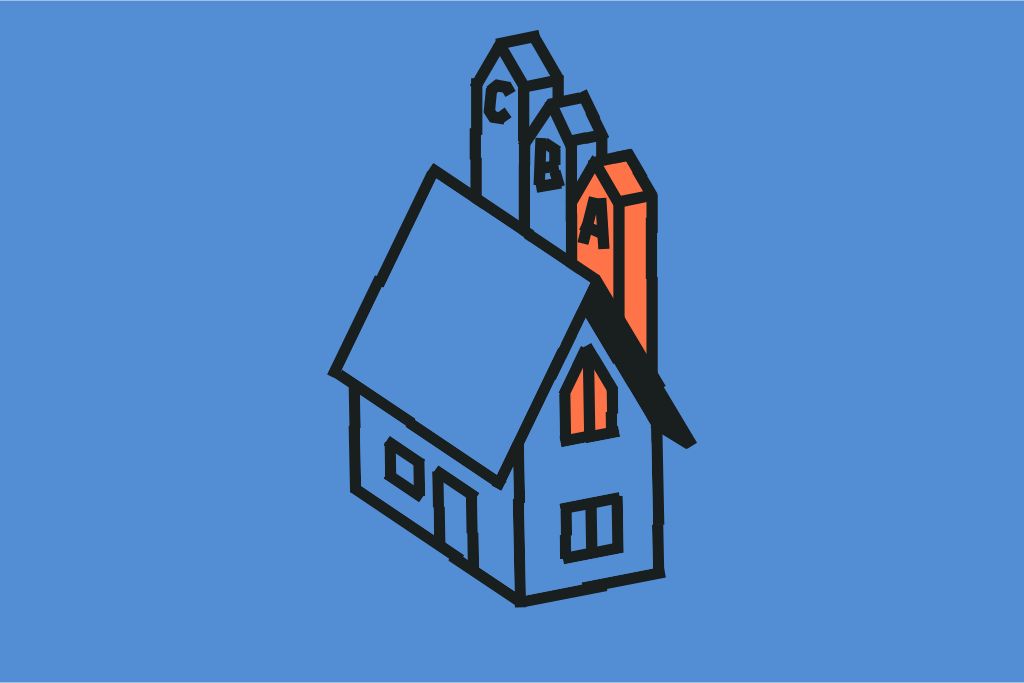What is energy label C?
Energy label C means that your home is reasonably well insulated and has a consumption of 190-250 kWh per m² per year. The energy label indicates that the house is reasonably energy efficient, but not yet optimal.
The energy label indicates that your house is reasonably well insulated and often has double glazing, a modern central heating boiler and sometimes solar panels. This means you use less energy than with lower labels. For you, this means lower energy bills, a more comfortable home and a more stable home value.
Want to know what label your home has? Then simply request a new energy label.
{{cta}}
When do you have energy label C?
A house receives energy label C when its energy consumption is between 190 and 250 kWh per m² per year. This is the main condition for energy label C.
Requirements and characteristics of energy label C
- The house is reasonably well insulated, but not yet fully insulated.
- Often present: double-glazed or older double-glazed windows.
- Heating with a modern central heating boiler (sometimes combined with solar panels).
- The house uses less energy than a home with label D, but more than a home with energy label B.
- Suitable for further preservation with relatively simple improvements.
Want to know when you have which energy label? Check out our overview explaining all energy labels from A to G.

Advantages and disadvantages of energy label C
Energy label C means that your home is reasonably energy efficient and has affordable energy costs. The downside is that the charges are higher than for energy label B or A and the home value and mortgage terms are less favorable.
Advantages of energy label C
- Affordable energy costs: a home with energy label C has reasonably low energy consumption compared to older homes.
- Reasonable living comfort: the house is usually reasonably well insulated and double-glazed.
- Higher home value than at D or below: buyers expect more comfort and lower expenses.
- Flexible to improve: with additional insulation and solar panels, you can quickly move to a better energy label.
Disadvantages of energy label C
- Not energy efficient enough: your energy costs are significantly higher than with label B or A.
- Lower home value than with A or B: buyers see a C label as less attractive.
- No mortgage benefits: with an energy label C, you usually don't get additional loan space or interest rate discounts.
Want a better label and make your home more attractive to buyers? Then take energy-saving measures and easily apply for a new energy label.
{{cta}}
Energy costs of a house with energy label C
A home with energy label C costs on average €8400 per year in energy, which amounts to about €700 per month for a single-family home of 120 m².
This is based on an average consumption of 190-250 kWh per m² per year and the current electricity price of €0.27 per kWh in September 2025, according to ANWB. In practice, energy costs may vary. This depends on factors such as insulation, the number of occupants, the type of home and energy use.

How do you improve energy label C?
You improve energy label C by adding extra insulation, replacing double-glazing, installing solar panels and a (hybrid) heat pump.
Key areas of improvement for a home with energy label C are:
- Additional insulation: roof insulation, cavity wall insulation or floor insulation.
- Replacing older double glazing with HR++ or triple glazing.
- Installation of a heat pump (hybrid).
- Installing or expanding solar panels.
- Smart schemes such as an energy consultant who prepares improvement suggestions.
By taking these measures, you reduce energy consumption, improve your home's energy performance and contribute to the environment.

What does energy label C mean for your mortgage?
Energy label C gives you €5,000 extra borrowing space on top of your maximum mortgage. This is less than the €10,000 extra for a home with label A or B.
Do you want to become more sustainable? Then you may even borrow an additional €15,000, as long as this amount is spent on energy-saving measures such as cavity wall insulation, a heat pump or extra insulation.
A home with label C has a more stable market value than a home with energy label D, but lags behind homes with green energy labels such as A.

Frequently asked questions about energy label C
Still have questions about energy label C? You're not the only one. Many homeowners want to know whether a house with energy label C is good or bad, what the conditions are and how you can improve this label. Below, we answer the most frequently asked questions briefly and clearly, so you know exactly what this label means for your home and wallet.
Is energy label C good or bad?
Energy label C is considered reasonably energy efficient in the Netherlands, so not bad. A house with energy label C has lower gas consumption than a house with energy label D or energy label G. Still, energy efficiency is not as high as with energy label A, so there is still room for improvement.
What are the requirements for energy label C?
A house gets energy label C if it uses an average of 190 to 250 kWh per m² per year. Your house must be reasonably well insulated, often with double- or HR-glass. For offices and business premises, since Jan. 1, 2023, there is even an obligation to obtain at least a valid energy label C to still be allowed to rent out.
What is the energy consumption of a home with energy label C?
A house with energy label C consumes an average of 190 to 250 kWh per m² per year. That means your electricity and gas consumption is lower than with a lower label, but higher than with energy label B or A. For a detached house, monthly energy costs often fall higher than for an apartment, because larger buildings use more energy.
How do you improve a home from energy label C to B?
You improve a home from energy label C to B by applying additional insulation and energy-saving measures. Important steps are floor insulation, insulating the cavity wall and replacing double glazing with HR++ glass. With these suggestions, your energy consumption decreases, you lower your energy bill and you increase the chances of a better label.
What is the difference between energy label B and C?
The difference between energy label B and C is in energy consumption and energy efficiency. Label B means 160-190 kWh, while label C stands for 190-250 kWh per m² per year. So a house with energy label B is more energy efficient, which saves in your wallet. In addition, energy label B provides more living comfort than with energy label C.
How do you go from energy label C to A?
You go from energy label C to A by investing in sustainability measures such as extra insulation, solar panels and a heat pump. These steps allow your home to use less fossil energy and achieve a new energy label A. For energy efficient living, this is the direction in which more and more homes in the Netherlands are moving, resulting in lower bills and a better climate.
{{vragen}}
Comparing energy label C with other energy labels
Energy label C means that your home uses an average of 190 to 250 kWh per m² per year. This puts the label in the middle range: more economical than lower labels, but less energy efficient than the higher labels.
Energy consumption by label
Want to know exactly what each label means, including features and examples? Then read our article on what energy labels A to G mean.
Read about the other energy labels
- What does energy label A mean?
- What does energy label B mean?
- What does energy label D mean?
- What does energy label E mean?
- What does energy label F mean?
- What does energy label G mean?




